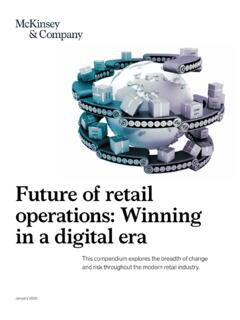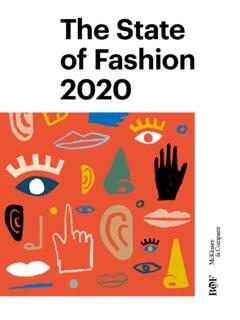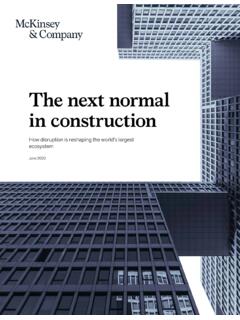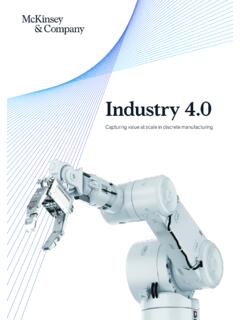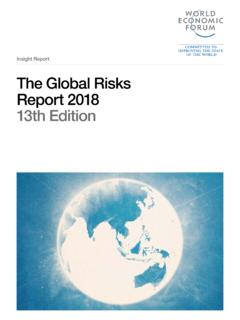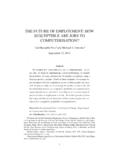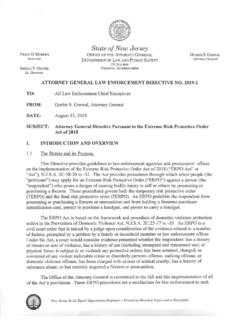Transcription of The future of bank risk management - McKinsey & Company
1 The future of bank risk managementAuthored by:Philipp H rleAndras HavasAndreas KremerDaniel RonaHamid SamandariMcKinsey Working Papers on Risk2 The future of bank risk management3 The future of bank risk managementBy 2025, risk functions in banks will likely need to be fundamentally different than they are today. As hard as it may be to believe, the next ten years in risk management may be subject to more transformation than the last decade. And unless banks start to act now and prepare for these longer-term changes, they may be overwhelmed by the new requirements and demands they will structural trends that are driving many of these substantial shifts stem from multiple sources.
2 Regulation will continue to broaden and deepen as public sentiment becomes less and less tolerant of any appearance of preventable errors and inappropriate business practices. Simultaneously, customers expectations of banking services will rise and change as technology and new business models emerge and evolve. Risk functions will also have to cope with the evolution of newer types of risk ( , model, contagion, and cyber) all of which require new skills and tools. Fortunately, evolving technology and advanced analytics are enabling new products, services, and risk- management techniques, while de-biasing approaches that improve decision making will help risk managers make better choices about risks .
3 However, the risk function of the future will probably be expected to deliver against all these requirements and deal with these trends at a lower cost, because banks will in all likelihood have to reduce their operating costs what will the risk function look like in 2025? It is likely to have broader responsibilities, to be very engaged at a strategic level, and to have much stronger, collaborative relationships with other parts of the bank. At the same time, its talent pool will probably have experienced a massive shift in expertise toward better analytics and greater collaboration, and away from operating processes.
4 Most of the latter can reasonably be expected to be automated, real-time, and paperless by then. IT and data will likely be much more sophisticated, often employing big data and complex algorithms. As a result, the risk function may be able to make better risk decisions at lower operating costs while creating superior customer banks want their risk functions to thrive during this period of fundamental transformation, they need to rebuild them during the next decade. To be successful, they need to start now with a portfolio of initiatives that balance a strong short-term business case with enabling the long-term achievement of the target vision.
5 Such initiatives could include digitizing the underwriting processes, use of machine-learning techniques, and interactive risk reporting. They should be complemented by enablers such as a shift in recruiting toward more technology-savvy profiles or the introduction of data lakes. However, to succeed, this transformation could also require a shift in the organizational risk culture the adoption of an approach that embeds shared and communicated values and principles throughout the summary4 Document Title Section Heading5 The future of bank risk managementRisk management in banks has changed substantially over the past ten years.
6 The regulations that emerged from the global financial crisis and the fines that were levied in its wake triggered a wave of change in risk functions. These included more detailed and demanding capital, leverage, liquidity, and funding requirements, as well as higher standards for risk reporting, such as BCBS 239. The management of nonfinancial risks became more important as the standards for compliance and conduct tightened. Stress testing emerged as a major supervisory tool, in parallel with the rise of expectations for bank risk-appetite statements. Banks also invested in strengthening their risk cultures and involved their boards more closely in key risk decisions.
7 They also sought to further define and delineate their lines of defense. Given the magnitude of these and other shifts, most risk functions in banks are still in the midst of transformations that respond to these increased 2007, no one would have thought that risk functions could have changed as much as they have in the last eight years. It is a natural temptation to expect that the next decade has to contain less change. However, we believe that the opposite will likely be we do not possess a crystal ball that will tell us what banks risk functions will look like in 2025, or what financial crises or technological changes may disrupt risk management between now and then, we believe that six structural trends are likely to fundamentally reshape banks risk management over the next ten paper first describes these six structural trends.
8 It then outlines how risk functions may look in 2025 and highlights what senior risk managers can and should do now to start preparing their functions to deal with these trends. Our insights and recommendations build on our experience serving a broad range of clients on risk management , research done on related topics ( , the future of banking overall, regulation, digital banking, and advanced analytics), and many discussions with senior executives, chief risk officers (CROs), and risk managers in banks future of bank risk managementWhile many other occurrences that will have a substantial impact on risk functions over the next decade are unpredictable, we believe that at least six key trends are powerful and certain enough to help paint a picture of the future risk 1: Continued expansion of the breadth and depth of regulationThe scope of regulation will continue to expand, propelled by four drivers.
9 First, public and hence government tolerance for bank failures has shrunk since the global financial crisis, and the appetite for interventions using taxpayers money to save banks has evaporated. After 2008, new regulations focused on the expansion of the regulatory framework by tightening micro- and macro-prudential regulation across the board. Open items still include the future of internal models for the calculation of regulatory capital and the potential use of a standardized approach as a floor; for instance, Basel IV is expected to reduce the complexity of banks internal models to narrow the differences between internal modeling and the standardized approach.
10 Such likely changes could have substantial implications, particularly for low-risk portfolios such as mortgages or high-quality corporate loans. However, apart from these, the future prudential framework is now largely in , governments are policing illegal and unethical behavior much more tightly. This has been driven by a general shift of attention toward financial crime, the vanishing tolerance for tax avoidance, and the perceived increased threat of terrorism from individuals and countries since the September 11, 2001, attacks in the United States. Authorities look at banks central role in the payment system and their access to customer data, and are making them increasingly responsible in their roles as lieutenants that police these policy objectives.
